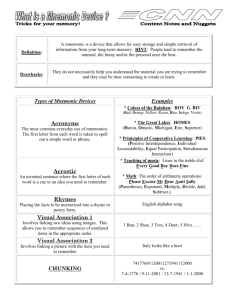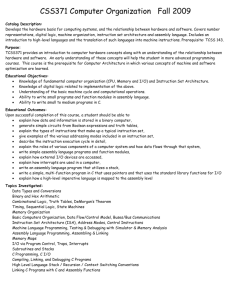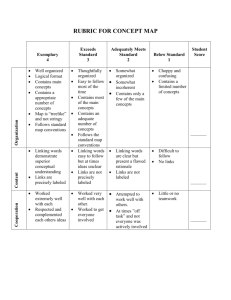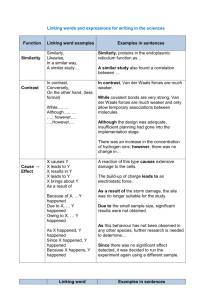s e u iq
advertisement
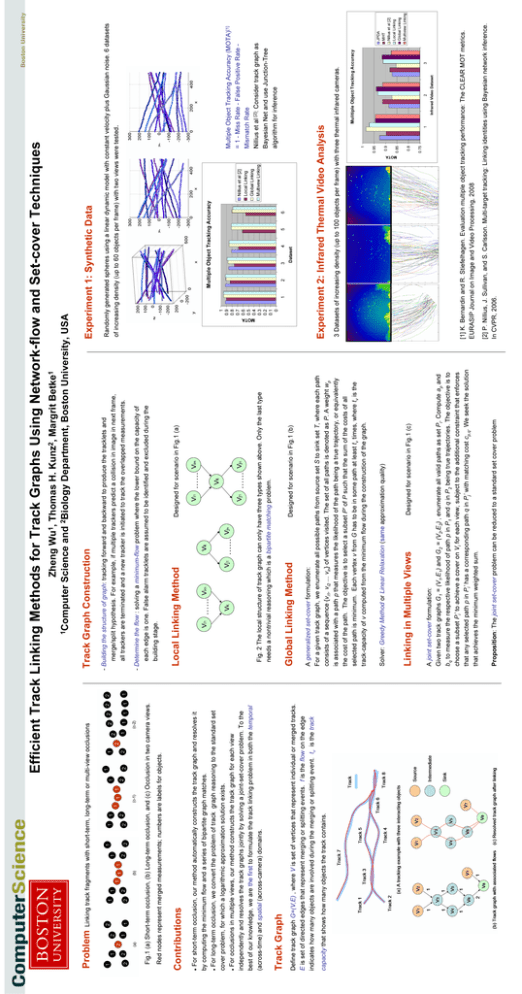
For short-term occlusion, our method automatically constructs the track graph and resolves it
capacity that shows how many objects the track contains.
Define track graph G=(V,E) , where V is set of vertices that represent individual or merged tracks.
E is set of directed edges that represent merging or splitting events. f is the flow on the edge
indicates how many objects are involved during the merging or splitting event. tv is the track
Track Graph
by computing the minimum flow and a series of bipartite graph matches.
For long-term occlusion, we convert the problem of track graph reasoning to the standard set
cover problem, for which a logarithmic approximation solution exists.
For occlusions in multiple views, our method constructs the track graph for each view
independently and resolves the track graphs jointly by solving a joint-set-cover problem. To the
best of our knowledge, we are the first to formulate the track linking problem in both the temporal
(across-time) and spatial (across-camera) domains.
Contributions
Red nodes represent merged measurements; numbers are labels for objects.
Fig.1 (a) Short-term occlusion, (b) Long-term occlusion, and (c) Occlusion in two camera views.
Linking track fragments with short-term, long-term or multi-view occlusions
Vk
Vim
Vj1
Vk
Vjn
Vj1
Vi1
Vk
Vjn
Vim
Designed for scenario in Fig.1 (a)
Designed for scenario in Fig.1 (b)
Designed for scenario in Fig.1 (c)
Proposition: The joint set-cover problem can be reduced to a standard set cover problem
A joint set-cover formulation:
Given two track graphs G1 = (V1,E1) and G2 = (V2,E2) , enumerate all valid paths as set Pi. Compute ap and
bq to measure the respective likelihood of path p in P1 and q in P2 being true trajectories. The objective is to
choose a subset Pi’ to achieve a cover on Vi for each view, subject to the additional constraint that enforces
that any selected path p in Pi’ has a corresponding path q in Pj’ with matching cost cp,q. We seek the solution
that achieves the minimum weighted sum.
Linking in Multiple Views
Solver: Greedy Method or Linear Relaxation (same approximation quality)
A generalized set-cover formulation:
For a given track graph, we enumerate all possible paths from source set S to sink set T, where each path
consists of a sequence {vi1, vi2 ... vin} of vertices visited. The set of all paths is denoted as P. A weight wp
is associated with a path p that measures the likelihood of the path being a true trajectory, or equivalently
the cost of the path. The objective is to select a subset P' of P such that the sum of the costs of all
selected path is minimum. Each vertex v from G has to be in some path at least tv times, where tv is the
track-capacity of v computed from the minimum flow during the construction of the graph.
Global Linking Method
Fig. 2 The local structure of track graph can only have three types shown above. Only the last type
needs a nontrivial reasoning which is a bipartite matching problem.
Vi1
Local Linking Method
- Determine the flow : solving a minimum-flow problem where the lower bound on the capacity of
each edge is one. False alarm tracklets are assumed to be identified and excluded during the
building stage.
- Building the structure of graph: tracking forward and backward to produce the tracklets and
merge/split hypothesis. For example, if multiple trackers predict a collision in image in next frame,
all trackers are terminated and a new tracker is initiated to track the overlapped measurements.
Track Graph Construction
1
2
4
Dataset
3
5
6
Nillius et al [2]
Local Linking
Global Linking
Multivew Linking
1
Infrared Video Dataset
2
3
[2] P. Nillius, J. Sullivan, and S. Carlsson. Multi-target tracking: Linking identities using Bayesian network inference.
In CVPR, 2006.
[1] K. Bernardin and R. Stiefelhagen. Evaluation multiple object tracking performance: The CLEAR MOT metrics.
EURASIP Journal on Image and Video Processing, 2008
0.75
0.8
0.85
0.9
0.95
1
Mulitiple Object Tracking Accuracy
3 Datasets of increasing density (up to 100 objects per frame) with three thermal infrared cameras.
JPDA
MHT
Nillius et al [2]
Local Linking
Global Linking
Multiview Linking
Multiple Object Tracking Accuracy (MOTA)[1]
= 1 - Miss Rate - False Positive Rate Mismatch Rate
Nillius et al [2]: Consider track graph as
Bayesian Net and use Junction-Tree
algorithm for inference
Experiment 2: Infrared Thermal Video Analysis
1
0.9
0.8
0.7
0.6
0.5
0.4
0.3
0.2
0.1
0
Multiple Object Tracking Accuracy
of increasing density (up to 60 objects per frame) with two views were tested.
Randomly generated spheres using a linear dynamic model with constant velocity plus Gaussian noise. 6 datasets
Experiment 1: Synthetic Data
MOTA
Problem
Zheng Wu1, Thomas H. Kunz2, Margrit Betke1
1Computer Science and 2Biology Department, Boston University, USA
Efficient Track Linking Methods for Track Graphs Using Network-flow and Set-cover Techniques
MOTA


